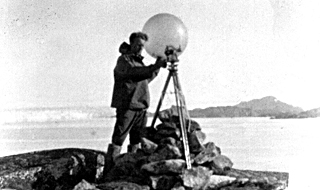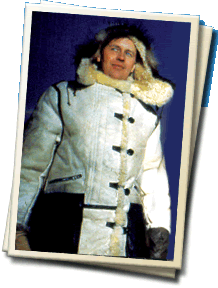
The late William S. Carlson, for whom the University of Delaware's International Polar Year public events are named, was president of UD from 1946 to 1950 and an accomplished polar explorer and scientist. The following biographical information was obtained from the University of Delaware Archives and the University of Toledo's Ward M. Canaday Center by Frederick "Fritz" Nelson, professor of geography, director of the UD Permafrost Group, and a member of the Intergovernmental Panel on Climate Change, which shared the 2007 Nobel Peace Prize.
William S. Carlson was born to Samuel and Mary (Lamsted) Carlson in the Upper Peninsula city of Ironwood, Michigan, on November 18, 1905. In 1932, Carlson was married in Ann Arbor to another native of Ironwood, Maryjane Rowe, who died in 1981. Their daughter, Kristin Rowe Carlson, is a retired professor of medicine at the University of Massachusetts Medical School in Worcester. Dr. Carlson died on May 8, 1994, of lung cancer. His second wife, Claire Callan Carlson, attributed his fatal disease to second-hand smoke.
Carlson earned B.A. (1930), M.S. (1932), and Ph.D. (1937) degrees from the University of Michigan in Ann Arbor. During 1931, he studied at the University of Copenhagen under the terms of a Henry Goddard Leach Fellowship from the American Scandinavian Foundation, and in 1935 studied at Columbia University. In 1927, he was an assistant in geology at the University of Michigan and also served as a special assistant with the U.S. Weather Bureau at Royal Center, Indiana. In the course of his graduate programs at the University of Michigan, he served as an instructor (1932–33) and was a graduate fellow in 1933. His adviser at Michigan was William Herbert Hobbs, a well-known geologist, geographer, and authority on polar exploration.
Carlson served as “assistant aerologist” on the University of Michigan Greenland Expedition of 1928–29, and led the fourth UM Expedition in 1930–31. During 1929, he was a technical adviser on Greenland to the Chicago Tribune.

Carlson surveying in Greenland in 1930. Photo
courtesy
of University of Toledo Ward M. Canaday Center
Following his return to Michigan from Denmark and Greenland, Carlson served as an instructor of history at the Ironwood high school (1933–34) and principal of the Wakefield and East Lansing high schools (1934–36 and 1936–37, respectively). After completing the doctorate, he was appointed assistant professor of education and director of the Training School at the University of Minnesota in 1937. He was promoted to associate professor in 1939 and to director of admissions in 1941. He retained this title while on leave for military service during WW II and upon discharge from the U.S. Army in 1945 was promoted to professor and dean of admissions and records. His service to the state also included a term (1937–41) as secretary of the Minnesota Association of Secondary School Principals.
In 1941, Carlson’s experience in Greenland led to his appointment as special consultant on Arctic problems to the U.S. Army Air Forces (USAAF). The next year, he was commissioned as a major in the USAAF and was then promoted through the grades to his 1945 commission as colonel. His wartime appointments included chief of the Special Projects Branch of the Plans Division at Army Air Forces Headquarters (1943), executive officer of the Western Hemisphere Plans Division (1943–44), and director of the Arctic, Desert, and Tropic Information Center (ADTIC) in 1944–45. Carlson was instrumental in creating the latter organization, which was headquartered in New York City. The officers serving under Carlson at ADTIC formed a veritable Who’s Who of post-war luminaries in Arctic science, including Richard Foster Flint, Laurence M. Gould, and A. Lincoln Washburn. ADTIC personnel (including Carlson) played a leading role in creating the Arctic Institute of North America, whose U.S. branch was initially headquartered at the American Geographical Society in New York. Carlson’s USAAF service included establishment of four northern air bases and developing several important air routes through the Arctic, as detailed in his 1962 book Lifelines Through the Arctic. After the war, he maintained the rank of colonel in the U.S. Army Officers Reserve Corps. He was awarded the Legion of Merit and three campaign theater medals for his wartime service.
Carlson was elected to the presidency of the University of Delaware in 1946 and served in that position until April 1950. During his tenure, UD’s student body increased from 930 (the pre-war maximum) to 2,200 in 1949. Particular attention was paid to graduate education during Carlson’s presidency, and the University’s first Ph.D. programs (in chemistry and chemical engineering) were implemented during that period. Carlson supported efforts to desegregate the University of Delaware, and his administration oversaw admission of the first African-American students in the institution’s history. His desire to see the University of Delaware adopt a more outward-looking and internationally oriented program of education and research motivated him to recommend creation of a curriculum in geography, a goal that was realized in 1950.

Carlson authored numerous publications including
the books
Greenland
Lies North (1940) and Lifelines Through the
Arctic (1962).
In April 1950, Carlson left UD to assume the presidency of the University of Vermont, where he remained for less than two years. In January 1952, he was appointed the second president of the State University of New York (SUNY), a system comprised at that time of 33 campuses and 47,000 students. Over strong opposition from private colleges and some elements in the New York State Board of Regents, Carlson built SUNY into a comprehensive system with a well-defined research role and founded the University Center at Stony Brook in 1957.
In September 1958, Carlson accepted the presidency of the University of Toledo, where he remained until he retired in 1972. At Toledo, he oversaw the founding of many graduate degree programs, an ambitious campaign of building construction, and the addition of new satellite campuses. His crowning achievement was the 1967 transfer of the University of Toledo from municipal status to that of a state university.
Carlson published several books, including Greenland Lies North (1940), Lifelines Through the Arctic (1962), and The Municipal University (1962). He also authored numerous scientific and policy articles in scholarly journals. He held honorary degrees from Alfred University, Bowling Green State University, Dickinson College, Middlebury College, the University of Cincinnati, and the University of Michigan. In June 1950, the University of Delaware awarded him the degree of Doctor of Laws. He was a Fellow of the Explorers Club and the Arctic Institute of North America and held membership in many civic and scholarly organizations. The main library at the University of Toledo is named for Carlson.

 The
William S. Carlson International Polar Year Events are brought
to you through the generous support of the University of Delaware,
in cooperation with the American Geographical Society of New York City.
The series is part of an ongoing "UD and the Global Community
Series" presented by the Center for International Studies.
The
William S. Carlson International Polar Year Events are brought
to you through the generous support of the University of Delaware,
in cooperation with the American Geographical Society of New York City.
The series is part of an ongoing "UD and the Global Community
Series" presented by the Center for International Studies.
Campus sponsors include the Office of the Provost, Center for International Studies, Research and Graduate Studies, Office of Public Relations, UD Library, and UD's colleges -- Agriculture and Natural Resources; Arts and Sciences; Lerner College of Business and Economics; Engineering; Health Sciences; Human Services, Education and Public Policy; and Marine and Earth Studies.






